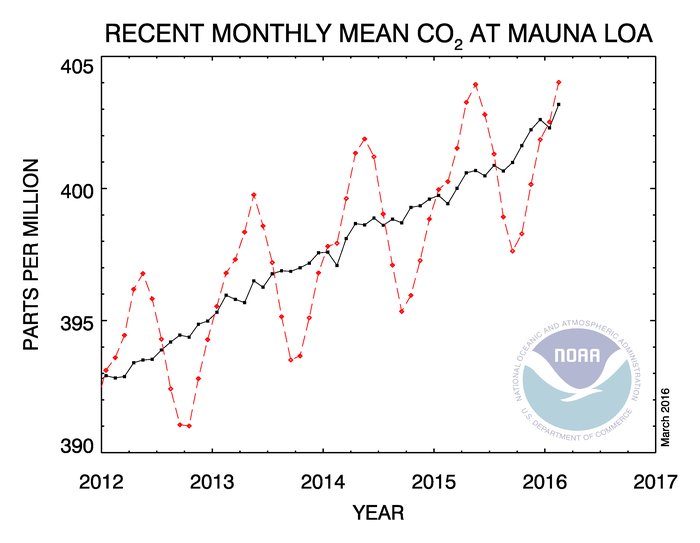Fastest Rise in CO2 Levels Seen in 2015

The annual growth rate of carbon dioxide in the atmosphere rose more in 2015 than scientists have ever seen in a single year, the National Oceanic and Atmospheric Administration announced Thursday.
It was the fourth year in a row that carbon dioxide concentrations grew by more than 2 parts per million, with an annual growth rate of 3.05 parts per million in 2015. The spike comes in the same year that Earth reached an ominous global warming milestone -- scientists last year measured the highest atmospheric concentrations of carbon dioxide ever recorded.
Carbon dioxide emissions from people burning fossil fuels are the driving force behind climate change and have risen to greater than 400 ppm — more than 120 ppm above pre-industrial levels. Earth has warmed more than 1.6°F over that period.
As of February, the average atmospheric carbon dioxide concentration in the earth's atmosphere was about 402.6 ppm, according to NOAA data. The findings are based on measurements made at the Mauna Loa Observatory in Hawaii.
U.S., Canada Pact Targets Lesser Known Climate Impacts China's Carbon Emissions May Have Peaked Already Study: California Methane Leak Largest in U.S. History
"Carbon dioxide levels are increasing faster than they have in hundreds of thousands of years," Pieter Tans, lead scientist of NOAA's Global Greenhouse Gas Reference Network, said in a statement.
The rate of increase in carbon dioxide concentrations is 200 times faster than the previous extreme jump between 11,000 and 17,000 years ago, when levels rose 80 ppm over about 6,000 years.
Get the world’s most fascinating discoveries delivered straight to your inbox.
NOAA scientists are blaming last year's spike in carbon dioxide concentrations on what will likely be the most extreme El Niño ever recorded, as ecosystems respond to the changes in temperature and precipitation it has caused.
Michael Mann, an atmospheric science professor and director of the Earth System Science Center at Penn State University, who is unaffiliated with NOAA, said the carbon dioxide milestone shouldn't be over-interpreted.
"This spike is almost certainly due in substantial part to the ongoing El Niño event, which is a fleeting effect that increases carbon dioxide concentrations temporarily," Mann said. "Carbon dioxide concentrations are a lagging indicator, and they don't accurately reflect recent trends in the more important variable — our actual carbon emissions."
Emissions, he said, have stabilized somewhat in recent years and dropped slightly in 2015, reflecting human progress in transitioning away from a fossil fuel economy, he said.
"Those are the numbers to keep a close eye on," he said. "If they continue to decline, we will see carbon dioxide concentrations beginning to stabilize."
You May Also Like: Longest Global Coral Bleaching On Record Isn't Over Yet Scientists Turned Back the Clock on Climate Change Study Calls For Leaner 'Carbon Budget' to Slow Warming
Originally published on Climate Central.



